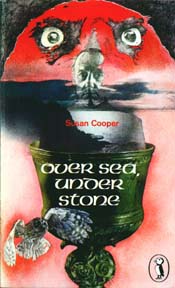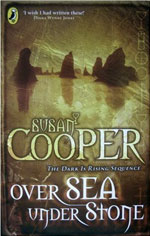

 "Susan
Cooper has woven into the story elements of the Arthurian legend, and created an
atmosphere of crackling tension... There is pace, suspense and mystery." (School Librarian)
"Susan
Cooper has woven into the story elements of the Arthurian legend, and created an
atmosphere of crackling tension... There is pace, suspense and mystery." (School Librarian)
When twelve-year-old Kate moved to Uruguay, her farewell to the public library was a request: "Please when Susan Cooper's new book comes, could you send me a copy? I don't know what the libraries will be like down there, and I can't possible wait three years to find out how it ends." And almost daily, in the hordes of requests for books on everything from astrolabs to zoology, there is one from a child who says, "my favourite book is 'Over Sea, Under Stone'. Can you find me another one like that?" After many years in print, the first volume of Susan Cooper's projected five-part sequence is enjoying a brisk readership on its own merits. What, in a period replete with well-written fantasies, gives this book such life?
First, Susan Cooper is a superb storyteller who uses all the instruments available to her - plot, character, setting, language - to create an atmosphere of expectant tension which propels the reader as well as the action. Her knowledge of folklore and archaeology adds dimension to the setting, enhancing the mystery and otherworldliness. The reader who has puzzled over "the signs that wax and wane but do not die" and has struggled to decipher the ancient map has shared an experience with the decoders of Stonehenge, for whom the great stones, like those at Trewissick, represented the key to a complex puzzle.
Second, there is the clearly drawn line between good and evil - with occasional ambiguities for the sake of suspense. One knows immediately which characters to cheer for; but whether their strength will be sufficient to overcome the enemy is in doubt until the very end. This is the stuff of melodrama to be sure; but it is also the underlying theme of the entire series, the struggle between good and evil which "goes on around us all the time, like two armies fighting. And sometimes one of them seems to be winning and sometimes the other, but neither has triumphed altogether. Nor ever will... for there is something of it in every man."
The third life-giving ingredient is the verisimilitude with which the relationships among the three children are drawn. Like most siblings, they bicker and tease, are alternately companionable or querulous, but unite when confronted with the enemy. Their conversation is in the language of real children; their enthusiasm and their fears are real and contagious. In the words of one young reader, "It's not just mystery; it's about people too."
Only Jane strikes a momentary sour note. Cautious and proper, careful to carry a clean handkerchief and follow parental rules, she is clearly a prefeminist character. One might wish that she were less inclined to be fastidious and to quaver anxiously when danger threatens. Yet even here, the author's sense of balance triumphs; Jane is as good as her brothers at following clues and solving riddles, and the boys, in their turn, are not ashamed to acknowledge their own fears.
Perhaps it is just this balance which holds the tale together so effectively. Susan Cooper seems to know just which note to strike at any moment; whether to excite or to soothe, to tease or fill with awe. And we respond, with her characters, to an experience which, because it is so real, we cannot forget.
( from the Horn Book Review (A Second Look) - 1976 )
![]()
Over Sea, Under Stone provided my second and eagerly awaited dip into the Dark Is Rising series (my first being The Dark Is Rising). I read it back-to-back with Greenwitch while staying at my Great Aunt's house. For a whole weekend I was transported to Cornwall and to the town of Trewissick.
 Over Sea, Under Stone is a mixture of
influences. The book certainly starts of as an adventure story (the reason for
its conception), but the Arthurian elements are clear from the very beginning.
It is the ominous overtones presented by Merriman that allow the sinister
presence of the Dark to be felt by the reader. For the Dark is present in this
book; not so much of a malevolent or supernatural force as in the other stories,
but there are characters to make you squirm in Hastings, the Withers and,
surprisingly, the housekeeper Mrs Palk. But there are allies here too like Mr
Penhallow and, though not seen, Captain Toms.
Over Sea, Under Stone is a mixture of
influences. The book certainly starts of as an adventure story (the reason for
its conception), but the Arthurian elements are clear from the very beginning.
It is the ominous overtones presented by Merriman that allow the sinister
presence of the Dark to be felt by the reader. For the Dark is present in this
book; not so much of a malevolent or supernatural force as in the other stories,
but there are characters to make you squirm in Hastings, the Withers and,
surprisingly, the housekeeper Mrs Palk. But there are allies here too like Mr
Penhallow and, though not seen, Captain Toms.
Susan Cooper describes the Drews, rather harshly, as "singularly dated" and expresses the wish that she could have developed the characters more. I'm not so sure. The book is very exciting and rewarding. There are no neat ends to the story and the way is paved for the next element in the series. We are left in no doubt that something else is coming and the quest for the Grail and its secrets needs to be completed at another time.